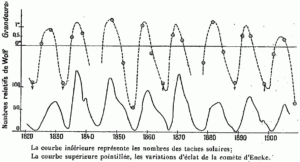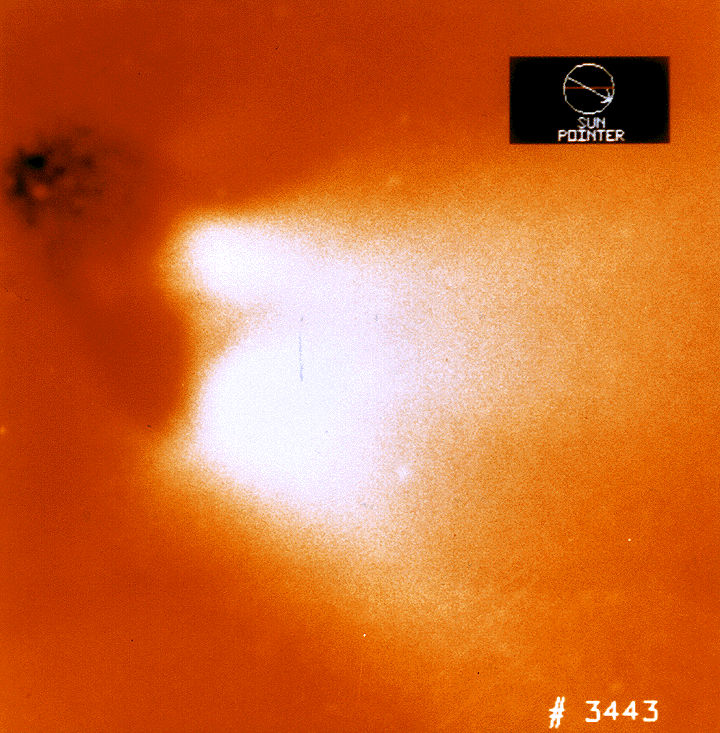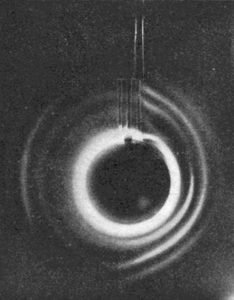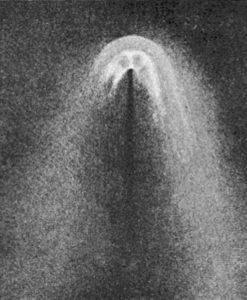Kristian Birkeland‘s theory of comets derives from his laboratory experiments with rarefied gases in a discharge tube. He presented his theories in his book, The Norwegian Aurora Polaris Expedition 1902-1903 published in 1913. [1] (See reference for download link to section full text).
Birkeland’s theory describes how comets interact with “corpuscle rays” (the plasma of the interplanetary medium), charge electrically and produce jets that result in their erosion, and, other characteristics such as the deflection of a comet’s tail, to dark spaces in the coma.
Contents
Electrical corpuscle-rays
- “The theory here set forth, of the emanation of electrical corpuscle-rays from the sun, might be thought to present a new point of departure in the study of the physical nature of comets, and more especially of comets’ tails.
- “It seems evident from their spectrum that comets consist of an accumulation of cosmic dust, with various carbonaceous substances, concentrated about one or more nuclei, which are surrounded by a highly rarefied vaporous envelope in which possibly carbonaceous gases are comparatively strongly represented.
- “As regards more especially the particular phenomenon of the comet’s tail, it has been found that it does not make its appearance until the comet approaches the sun, and is most highly developed a little while after passing the perihelion. If, now, this vaporous envelope surrounding the more solid part of the nucleus, be exposed to the radiation of a multitude of corpuscle-rays from the sun, it could easily be imagined that in their passage through the exceedingly rarefied gas, these rays would change their nature. The simplest assumption one is inclined to make is that some of the corpuscles that pass through the coma have acquired an appendix of gaseous atoms or molecules, which have thereby become luminous. As these rays may be supposed to continue their way in more or less the same direction as before, but with a different velocity and mass, this would be a comparatively simple explanation of the luminous tail of the comet, which is almost always directed away from the sun.”
Cometary charging
- “It is possible, however, that there are also other, just as natural, ways of looking at the matter. It might be imagined that after great heating by direct insolation, the comet is charged negatively by cathode-rays from the sun, and that the charging reaches so high a potential that the comet discharges itself electrically, so to speak in the direction of its own shadow. These discharges may also be imagined to be due to some extent to an emission of secondary rays from the cosmic dust of the comet. I have been led to this thought by experimental analogies which will be described farther on. Answering to the idea that a comet is an accumulation of carbonaceous cosmic dust almost without atmosphere, I have carried out experiments in which the cathode in a vacuum-tube consisted of a carbonaceous material. The most recent investigations of the comet-spectrum seem to indicate that the radiation from a cornet may be compared to that from a cathode in a Crookes ‘ tube (DESLANDRES, FOWLER).”
[..]
- “It would be natural, therefore, to compare the above-mentioned layers that were favorable to the development of comet ‘s tails with the pencils of the strongest and magnetically stiffest corpuscle-rays which we imagine to emanate from the region surrounding the sun-spots, and which, when they sweep past our earth, produce powerful magnetic disturbances. It may be that it is these very rays, with their abundance of energy, that can charge the comet mass to a high negative tension, and thus occasion the secondary electric discharge from the comet into space.
- “One circumstance that speaks strongly in favour of a hypothesis such as this, is the greater development thought to have been found in years of sun-spot maxima than in years of sun-spot minima. This has been demonstrated, for instance, in Encke ‘s comet, by BERBERICH and BOSLER, the latter having given an exceedingly interesting graphic representation of this condition, which is reproduced here. The agreement, as will be seen, is so striking that it seems to leave little room for doubt that we here have phenomena that must be intimately connected with one another.”

Cometary jets
- “For the purpose of seeing and studying how a substance containing carbon is discharged as a cathode in a vacuum tube, I have made, as already mentioned, numerous experiments with cathodes of ordinary coal, coke, graphite, and picein over a metallic cathode. I have further employed an extremely line jet of CO2, which was introduced through a very narrow capillary tube, and flowed out from the end of a narrow silver tube which served as cathode.
- “I succeeded several times in making this jet luminous, so that it had the appearance of a fine needle of light shooting out from the cathode, sometimes as much as 5 cm in length. A cathode of coal also sent out similar long needles of light from various points on its surface, round which the coal even became glowing.

- “Piceïin emitted long, thin pencils of light, often more than 10cm in length, one after another, as if by violent eruptions. These light-phenomena gave the impression that the electric discharge from both the coal cathode and the cathode with piceïn, was accompanied by eruptive outbreaks of gaseous rays, that were made luminous in the same way as the above-mentioned carbonic acid jet 231 1 and 2 show discharges of this kind.
- “From a cathode of graphite there came long, steady pencils of light, which greatly resembled the so-called eruptions or jets in comets.”
Cometary disintegration
- “In these experiments with cathodes containing carbon, the rapid disintegration of the cathode was especially remarkable. In the course of two or three minutes, large dark patches appeared on the glass walls just where the long pencils of light had come in contact with them. Fig. 1 shows an instance of this in the two dark tongues side by side above on the right. To this phenomenon, which is of peculiar importance to our theory, we shall have frequent occasion to return, for instance in the article on Saturn’s ring, where we assume that material particles are constantly being emitted in the plane of the ring by electric evaporation (disintegration), analogously to certain experimental observations to be described farther on.”
Cometary tail deflection
- “In connection with the above-mentioned experiments with carbonaceous cathodes, experiments were also made with cathodes of platinum thinly coated with lime. This was for the purpose of finding out whether rays from a cathode such as this — which, as is known, emits exceedingly soft rays — might be repelled by electric forces, and bent right round, just as the radiation from the head of a comet appears to be by apparent repulsion from the sun.
- “Fig. 231, 4 shows how the rays from a coated platinum cathode such as this, turn away from a large cathode-plate of brass on its right. The bending of the rays was sufficiently evident, and changed with changes in the tension employed upon the brass cathode ; but there was no appearance of any backward-streaming as in the tail of a comet, as the light ceased at a short distance from the cathode. It is very possible that better results might be obtained by an arrangement somewhat different to the one here employed. In J. J. THoMsnx’ s “Conduction of Electricity through Gases “, Second Edition, p. 632, the diversion of these rays by electric force is illustrated by a drawing, reproduced here in fig. 232, which shows how the rays can be turned right back.
- “It will be of interest for the present question to cite, and reproduce a drawing of, an experiment described by J. Stark, in “Die Elektrizität in Gasen” published in Winkelmann’s “Handbuch der Physik”, B.4, p. 582:
-
- “”If a cathode-ray with a certain initial velocity enters an electric field that is at right angles to its direction, it will be deflected out of its course from points of lower to points of higher tension. If its initial velocity is very small, it soon takes exactly the direction of the electric line of force in which it lies ; if; on the contrary, it is great, it will be deflected more or less in the direction of the line of force, the less so the greater its velocity, the more so the greater the strength of the field.
-
- “Let us consider the case in which rays from one cathode fall upon a second. In figs. 233 a & b, S is the transverse section of a metal pin that can be connected with the cathode outside the tube. If, together with the wire-anode beside it, it is connected with the earth the primary rays cast a sharp shadow of it (233 a). This immediately increases when the pin is connected with the cathode ; for there is then formed about it the powerful electric field of the dark space of the cathode, and through this the approaching cathode-rays are turned aside (233b)”.
- “According to this, it might well be imagined that luminous pen oils of rays, emitted by electric discharges from a comet, are bent backwards by the electric force of cathode-rays from the sun, in such a man ner that the discharges pursue their course almost in the direction of the comet’s shadow, forming approximately a cone, possibly on account of the mutual repulsion of the pencils of rays emitted.”
Cometary coma dark spaces
- “Another circumstance favorable to the assumption of the existence of such negative discharges from comets, is that of the various envelopes separated by dark interspaces so often observed in the heads of comets. Fig. 234 shows the head of Donati ‘s comet (1858). For several weeks the coma exhibited in iinrivalleri nerfertion the develonment and structure of concentric envelopes. It is easy to produce, round a globe as cathode in a large vacuum-tube, several concentric luminous envelopes separated by dark spaces. These different envelopes are more distinctly seen when the globe used as cathode is magnetised. In this case the originally spherical envelopes will be flattened so as to form a ring in the magnetic equator. Fig. 235 gives a representation of such an experiment. Such envelopes, as we know, contract or expand according as the gas-pressure in the vacuum-tube becomes greater or less. The very singular phenomenon of the contraction of the comet’s head with the approach of the comet towards the sun can be reasonably explained by this view. Instead of expanding, as one would naturally expect it to do under the action of solar heat, the comet’s head contracts when near the sun, just because the gas pressure about the comet becomes higher there, and the electrically-formed luminous envelopes therefore contract.
- “On some occasions comets have been furnished with several tails in a manner that is not quite easy to explain by the assumption that an emanation of tail-material from the comet could directly give rise to all the tails.”
Notes
- ↑ The Norwegian Aurora Polaris Expedition 1902-1903 Part II, Chapter 5. Is It Possible To Explain Zodiacal Light, Comets’ Tails, And Saturn’s Ring By Means Of Corpuscular Rays? (1913) ACADEMIC BOOK Section 124. Comet Tails FULL TEXT
- ↑ M. J. Bosler, “Sur les variations d’éclat de la comète d’Encke et la période des taches solaires” FULL TEXT (1909) Comptes rendus hebdomadaires des séances de l’Académie des sciences, 1909 (T. 148). Chart: page 1740. PEER REVIEWED


